Medical malpractice occurs when a healthcare professional deviates from the standards of their profession, resulting in harm to a patient. Understanding the most common types of malpractice can help individuals recognize potential issues and seek justice if they experience negligent care.
Misdiagnosis or Delayed Diagnosis
Misdiagnosis and delayed diagnosis are among the leading causes of malpractice claims. A doctor failing to diagnose a condition accurately or promptly can prevent a patient from receiving the necessary treatment, potentially worsening their condition. For example, a missed cancer diagnosis can lead to the disease progressing to an untreatable stage. Legally, these cases hinge on proving that another competent doctor would have made the correct or timely diagnosis under similar circumstances.
Surgical Errors
Surgical errors encompass a range of mistakes, such as operating on the wrong body part, leaving surgical instruments inside the body, or causing organ damage during surgery. These errors can have severe consequences, including additional surgeries, infections, or even death. In legal terms, proving surgical malpractice involves demonstrating that the surgeon's actions were below the accepted standard of care, directly resulting in the patient's injury.
Medication Mistakes
Medication errors are prevalent in medical settings and can occur in various forms, such as prescribing the wrong medication, incorrect dosage, or failing to identify drug interactions. These mistakes can lead to adverse drug reactions or ineffective treatment, posing serious health risks. Legal claims for medication errors typically focus on the healthcare provider's failure to follow proper protocols, resulting in harm to the patient.
Birth Injuries
Birth injuries can occur due to negligence during prenatal care or delivery, affecting both the mother and child. Common issues include brain injuries due to lack of oxygen, nerve damage, or fractures. The emotional and financial impact on families can be profound, requiring long-term care and support. Legally, these cases involve proving that the healthcare provider's negligence during the birth process directly caused the injury.
Anesthesia Errors
Anesthesia errors, while less common, can be incredibly dangerous. These errors might include administering too much or too little anesthesia, failing to monitor the patient appropriately, or not recognizing adverse reactions. Such mistakes can lead to brain damage, paralysis, or death. In a legal context, proving anesthesia malpractice involves demonstrating that the anesthesiologist failed to adhere to standard care practices, leading to patient harm.
Legal Implications of Medical Malpractice
For victims of medical malpractice, the legal journey involves establishing that the healthcare provider's negligence directly resulted in harm. This typically requires:
- Expert Testimony: Medical experts are often called upon to testify that the care provided fell below the expected standard.
- Documentation: Comprehensive medical records and incident documentation are crucial in supporting a malpractice claim.
- Statute of Limitations: It's important to know the time limits for filing a malpractice lawsuit, which vary by jurisdiction.
Hawaii Medical Malpractice Attorneys
At Davis Levin Livingston, we understand the complexities and challenges associated with birth injuries and medical errors. Our experienced legal team in Honolulu, HI is dedicated to advocating for your rights and ensuring you receive the compensation and support you deserve. If you or a loved one has been affected by a birth injury, contact us today at (808) 740-0633 to learn how we can assist you in navigating the legal process and securing a brighter future for your family.

